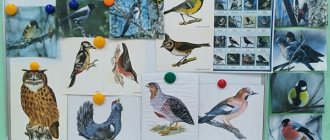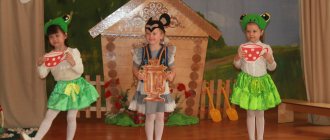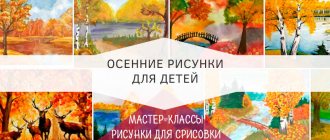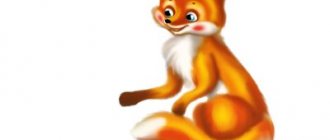Self-analysis of the integrated lesson
MUNICIPAL BUDGETARY PRESCHOOL EDUCATIONAL INSTITUTION
“KINDERGARTEN “SWALLOW” A. KYZYL – OCTOBER”
Self-analysis of an integrated lesson on artistic and aesthetic education in the preparatory group on the topic:
"Travel with Luntik"
Prepared by: teacher: Chomaeva G.I.
Self-analysis of an integrated educational activity for artistic and aesthetic development in the preparatory group “Travel with Luntik”
Chomaeva Gulmira Idrisovna
Introspection.
GCD in the preparatory group.
Topic: "Travel with Luntik"
Integration of educational areas:
gaming, artistic - aesthetic, cognitive-research, productive, socialization.
Target :
Form artistic thinking and moral traits
personality through the unconventional painting technique “Stained Glass”
Tasks :
Educational:
• Continue to teach children independently
and creatively reflect your ideas about nature using the non-traditional painting technique “Stained Glass”
-Introduce children to sea salt crystals, the method of obtaining sea water and its properties (density and ability to dissolve substances)
-To consolidate children's knowledge about the underwater world
Educational:
• Develop a cognitive interest in nature
.
• Develop imagination, color perception, sense of composition, creativity, cognitive abilities of children.
• Develop skills in conducting laboratory experiments, skills in working with solutions.
• Improve the grammatical structure of speech, develop coherent speech.
Educational:
• Foster independence
, curiosity.
• Cultivate interest in experimental activities
• Cultivate artistic taste and interest
to fine arts
Materials and equipment:
Laptop or multimedia installation;
Presentation "Underwater World";
Map showing the seas;
Cartoon about Luntik;
Stained glass paints; sketches of drawings; files; Audio recording Sound of the sea;
Decoration “ship”; sand ;
Aquarium ;
Container with water, egg, fine salt;
GCD structure
First part (introductory)
.
Org. Moment. and Psychogymnastics. Contributed to the creation of psychological comfort. We set the children up for active work, positive contact with each other, provided psycho-emotional release, and created interest in the upcoming activity
.
The second part
(Introduction to a game situation with the fairy-tale hero Luntik,
created a problematic situation with Luntik and the children, together with Luntik, were looking for the lost card.
Physical education was carried out
. To prevent fatigue.
Conducted an experiment with children.
The purpose of the experiment was to form an understanding of sea salt crystals and the method of obtaining sea water. to form the idea that sea water, as it were, pushes objects out, helping objects stay on the surface of the water surface.
She used the artistic word as a means of activating existing knowledge about the sea. Relaxation was carried out, the children were asked to close their eyes and imagine that they were sitting on the seashore. The children pretended to put on masks. This stimulated acceptance of elements of the learning task
, created
interest
and playful motivation for the content of the lesson. Breathing exercises were used to develop the respiratory organs.
The third part.
Created a second problematic situation “How Papa Octopus Lost His Babies” »
.
Organized a search for a way out of a problematic situation. As a result, we moved on to visual activities
and getting acquainted with the history of the creation of “Stained Glass Art”
In joint productive activities, they consolidated previously acquired skills in painting with stained glass paints.
Fourth
part .
In the final part, NOD used a literary word to summarize
.
There were surprise moments (Treat from Baba Kapa)
. She consolidated the positive results of the lesson with verbal encouragement and reflection.
Throughout the course of the educational program, I improved the grammatical structure of my speech and developed coherent speech. I sought answers in complete sentences.
The material for the educational activities was selected at a level accessible to children, corresponded to their psychological characteristics and was rational for solving the set goals and objectives. Taking into account their age characteristics, the children learned... The children were interested
.
They were active, attentive, and felt comfortable. All this is confirmed by the results of activity and reflection
.
All elements
GCDs are logically united by a common theme.
This structure of the lesson is completely justified. Since each part of the lesson is aimed at solving certain pedagogical problems and offers a choice of adequate methods and techniques. The content of the lesson corresponded to the set goal and objectives.
Activity
on GCD it is characterized as joint, creative, individual.
At GCD I used the following forms of work: frontal, individual, group .
Methods:
1. Verbal (questions for children, clarification, encouragement)
;
2. Visual demonstration ()
;
3. Practical ( drawing , experiments)
4. Game (correspondence trip to the sea kingdom
, physical minute and);
5. Control methods (analysis of completed tasks, evaluation of performance
);
6. Problem-search method (During the lesson, we looked for a lost card and returned his children to the octopus dad)
.
7. Experimental
.(conducted an experiment with salt and egg)
The following technologies were used in the GCD process:
-game activity
;
—activity approach
;
-training in dialogue with fairy-tale characters from the cartoon “Luntik”;
-technology of developmental education;
- health-saving technologies.
— experimental-search
.
I believe that the form of organization of direct educational activities
children was quite effective.
Throughout the entire educational activity, a UUD was formed
(universal educational
activity
, in accordance with the requirements of the Federal State Educational Standard of the NEO. I tried to comply with the norms of pedagogical ethics and tact. I believe that the tasks set in direct educational
activities
were completed. The NED achieved its goal.
Preview:
Self-analysis of GCD for drawing using non-traditional techniques “Winter Landscape”
Topic: “Winter landscape”
The lesson was conducted with children from the preparatory group; there were (7) children present. Children easily make contact with adults. They know how to hear and listen to the teacher.
When developing this lesson summary, I first of all took into account the age and mental individual characteristics of the children in the preparatory group.
Purpose of the lesson: to evoke aesthetic feelings towards nature and its images using an unconventional drawing technique.
During the lesson it was expected to solve the following problems
In accordance with the requirements of the Federal State Educational Standard, she used the following types of activities: gaming, cognitive, productive, motor.
-methods of consciousness formation (individual and frontal conversation);
-methods of organizing activities and developing behavioral experience (games, speech situations);
-methods of stimulating behavior (encouragement);
-methods of control, self-control and self-assessment (survey, analysis of the results of one’s own activities);
-methods of organizing and implementing cognitive activity (story, modeling a picture);
-methods of saving, preserving and strengthening health (games “Bring the Picture to Life”, finger play “Snowball”)
To successfully solve the identified problems, I have prepared the following:
Preparatory work: conversation about winter; viewing and talking about landscape paintings; drawing “Autumn landscape”; the use of modeling in direct educational activities.
Equipment and materials: models, tinted sheets of cardboard (for each child), stacks, skewers, ready-made dough for drawing; rags, Velcro pictures depicting objects and natural phenomena, plastic cups, audio recording of P.I. Tchaikovsky “Seasons. February” exhibition of paintings, presentation of paintings by famous artists.
The end result for the child: knows how to depict a winter landscape using an unconventional drawing technique, plans his activities and implements a preliminary plan, freely navigates a limited surface.
I think that drawing with non-traditional techniques aroused interest and activity among children.
The lesson consisted of three parts.
Contributed to the creation of psychological comfort. We set the children up for active work, positive contact with each other, provided psycho-emotional release, and created interest in the upcoming activity.
Aimed at creating a positive emotional mood and developing the educational situation itself. This part of the educational activity used a combination of game motivation, visual, verbal and practical methods.
1. To describe natural phenomena in winter, I used the didactic exercise “Winter - good, bad...”, as a result of which the children’s vocabulary is enriched with adjectives characterizing natural phenomena.
2. I solved the problem of developing visual perception, memory and logical thinking and cognitive activity in the process of viewing landscape paintings and working with model pictures related to the landscape.
3. Emotional expressiveness and the ability to convey the mood of a picture were reflected in the theatrical sketch-improvisation “A Picture Alive”. The children's ability to correlate words with movements and the expressiveness of performing movements was strengthened.
Determining the purpose of the topic (drawing a landscape)
Independent productive activity.
3. Final part.
Assessment of children's performance and self-esteem. Summing up the results of the GCD.
All stages of the lesson were interconnected and interdependent, subordinated to the given topic and goals of the lesson. Changing the type of activity at each stage of the lesson helped prevent fatigue.
I don’t forget that play is the leading activity for preschool children, so I offered the children the games “Winter – good, bad...”, “Picture Alive”.
During the lesson, to ensure the efficiency of the children's team, I used the following forms of organizing children's activities:
Team work with model pictures.
Throughout the entire lesson, I paid attention to the children’s speech: I sought complete answers, posed searching questions about how we could draw, and created conditions for dialogue with the children.
During the lesson, the children were active - they participated in the game and answered questions.
The children's interest remained throughout the lesson. The children were attentive.
Summing up the lesson, I involved the children in this and asked them to speak on the topic of what we know about painting and what other ways can we draw pictures.
CONCLUSIONS: – The stated topic was fully consistent with the content of the lesson.
— I believe that I managed to fully implement the assigned tasks.
Source
Analysis of the organization and management of drawing in the second junior group of kindergarten
Analysis of the organization and management of drawing in the second junior group of kindergarten.
Type of productive activity:
drawing (non-traditional method). Theme: “Beauty Violet.”
Amount of children:
10 people aged 3 to 4 years, second youngest group
The purpose of productive activity:
Develop aesthetic perception. To develop an interest in visual arts
Productive activity objectives:
To develop children’s ability to independently create a drawing tool that can be used to print. Consolidate knowledge about indoor plants (violet). Reinforce your knowledge of the names of colors - green, blue, purple, pink.
Develop the ability to experiment. Develop aesthetic perception, attention, creativity, fine motor skills.
To cultivate neatness, perseverance, and love of nature.
The teacher used the following materials and equipment:
doll, violet in a pot, photograph of a blooming violet, paper silhouette of a violet, white sheets of paper with pots and leaves already glued on, blue gouache, small sheets of paper.
Before carrying out productive activities, preliminary work was carried out with the children: looking at indoor violets, looking at photographs of violets, gluing a pot and leaves onto a sheet of paper.
The teacher used a surprise moment in her work - a beautiful doll named Violet comes to visit the children. In the main part, the teacher asked the children how to care for indoor plants. And the violet doll gave each child a paper flower (purple, pink, blue, lightly scented with essential oil with the aroma of flowers). Then the teacher conducted a breathing exercise, clarifying how to perform it correctly. Then, together with the teacher, we performed physical education.
She invited the children to thank the fairy for her gift and draw different violets as a souvenir for her. The teacher showed how to make signets from small sheets of paper using the crumpling method. Then, together with the children, use a signet to draw a violet: dip the signet in paint and press it to a sheet of paper. An imprint remains. The children began to work independently. When the children finished drawing, the teacher invited them to rest a little and play the finger game “Flowers”. In the final part, she praised the children: “Our guest fairy Violet really liked the flowers! She thanks you for such a wonderful gift. Violets love the sun very much. And now our kindergarten has become even brighter and happier. Well done boys"!
Violet is a fabulous flower,
Nobody can argue with that.
Creating wondrous beauty
And amazing stories.
The teacher, together with the guest and the children, examined the finished drawings, admired the unusual colors, and summed up the results.
In his work, the teacher used various methods and techniques:
surprise moment, play motivation, conversation, questions, demonstration with explanation, explanation, self-esteem, self-monitoring of task completion, individual approach to each child. The teacher’s speech was accessible, logical, and emotional. The teacher used words that the children could understand and emphasized important points with intonation. During the work, the children were active, they listened carefully, answered the teacher’s questions, and showed interest in completing the task.
The OOD outline was compiled methodically correctly, the time intervals of the parts were observed.
Recommendations:
Productive activities were interesting and exciting for children, tasks were understandable and therefore completed with pleasure. The set goals and objectives have been fully achieved.







